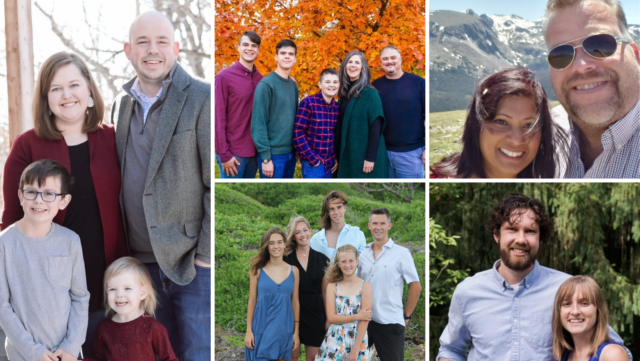As a national church multiplication team we are working diligently to encourage and resource Vineyard churches as the multiply in all the various ways that God might lead. And while we currently have over 30 multisite churches throughout the country, we are working to see at least 150 new sites over the next ten years in addition to the 750 church plants we are working towards.
A multisite is defined as “one church meeting in multiple locations.” And in this post we are interviewing one of our own Vineyard practitioners: Corey Garris. Corey is a Vineyard pastor. And until just recently Corey was the multisite coordinator for Vineyard Columbus in Ohio, and pastor of its Sawmill Campus. Today Corey is at the Mile High Vineyard Church in Denver Colorado, working to help that church multiply throughout the entire city.
Corey has many practical tips for pastors who are thinking about extending their current church to multiple campuses.
QUESTIONS TO ASK WHEN CONSIDERING MULTISITE
“There are so many really compelling reasons to pray about, to consider, to seek the Lord for your church’s future in terms of engaging in the multisite movement,” Corey says. He breaks down a few of the questions to work through.
1) Evangelism: Would extending to multiple sites advance the mission God has given my church?
What most churches emphasize, notes Garris, is that their primary reason for existing is to reach people for Christ. If so, multisite evangelism can greatly advance that cause. “The ability to reach people in their local context is far greater when you’re putting these ‘local little churches’—which is how they are really operating—in their neighborhoods.”
That’s where the 20-minute drive-time barrier makes a big difference. “The average person no longer really wants to drive more than 20 minutes,” Corey explains. “When you talk about inviting your unchurched, maybe unsaved, neighbor to come to church, and ask them to drive 25 or 30 minutes, what we often see is that people might be willing to come to an Easter or Christmas Eve service. And they may love our church and think it’s great, but the reality is, they are unwilling to commit every week to come and participate.
“We lose our opportunity week after week to witness to them in the Sunday weekend context.”
Corey adds that believers who are involved in a multisite launch can take on a very missional mindset and begin to take ownership of the power they have to reach out to their neighbors, co-workers and friends. “They begin to say, ‘I’ve got somewhere I can take these people.’”
2) Discipleship: Will the closer proximity create a context for all types of people to grow?
As an example of the importance of proximity to a church body, Corey points to youth ministry. How many parents, he says, can’t afford to drop their kids off 30 minutes away and then pick them up later to drive them home? “We’re seeing participation levels in youth groups and small groups drop when there’s this large drive time. It’s an absolute barrier,” especially for opportunities during the week, he explains. But when campuses come into the communities and the drive time lowers to 5 or 10 minutes, participation levels rise.
And it’s not just participation in classes or small groups that increase, but also participation in serving and giving financially. “All those things that we would measure in terms of the question, ‘Is someone becoming more of a mature follower of Christ?’ come up on the discipleship scale when you have the proximity for them to be able to participate.”
3) Leadership Development: Could everyone actually get to play?
One of the core values of the Vineyard is that everyone, leader or layperson, can actively enter into what God has done and is going to do. At Vineyard Columbus, multisites aren’t immediately staffed with a group of people; they grow and then are staffed at the level of need. That requires a lot of different people to step up and serve in the initial launch stages of a multisite campus.
When planning for the Sawmill Campus began, Corey brought a grid with 75 or 80 open role slots to the campus interest meetings and told people, “If we don’t have people that feel called to participate in these roles, we can’t do this thing.” Now, around 120 people run the whole campus in every kind of role imaginable; the church is largely volunteer-led. And, says Corey, people’s skill sets are being challenged and expanded as a result.
“Oftentimes, in our larger churches, there is this tendency: The average person sitting in the pew looks at the size of the church and maybe says, ‘I’m sure it’s taken care of. I’m sure they’ve got it covered,’” Corey says. “There is this real assumption of, ‘They don’t need me.’ Unless they ask the leaders directly.
“In contrast, the campuses immediately create a context to say, ‘We need you. This doesn’t happen without you. Will you come and be on mission with us? And as you’re on mission with us, you will develop those gifts that God has put inside of you.’”
4) Practical Needs: Could my church benefit from space, size and cost considerations?
If a church is having a hard time fitting in 50 more chairs … if a church has gone to two services, then three … if pastors are burning out preaching too many messages a week … it can be hard to keep up the pace. “Just by opening another location, we begin to see some of that pressure released, and we create more room for new people,” Corey notes. “We know that when new people come in and see a room more than 80 percent full, they automatically assume there’s no room for them. We’re sending them a message that we don’t intend to send them.
“By starting campuses, we create more room at the new location as well as the original location so more people can come in and feel welcome.”
Stewardship is another practical need that can be positively affected by a multisite. Some newer studies have shown that dollar for dollar, it’s much cheaper to connect a person with Christ using a multisite plan than by church planting. Of course, Corey says, there’s room and need for both in the Vineyard. But taking a good look at the cost analysis, a multisite campus can and should be a viable option.
Logistically, one further advantage a multisite church can provide is to retain the “family feel.” “We offer people sort of the ‘big-church quality’ with resources and ministry and preaching, but with that small church family community feel,” Corey says. “You get the blend of the best of both worlds in that place.”
FIRST STEPS
For those who have considered the questions, prayed and feel confident that a multisite location is the best choice for a church, what are the first things to focus on?
Choose the Right Leader
“Everything rises and falls on leadership,” Corey advises. The right kind of campus pastor is one who can communicate the church’s vision, who embodies its DNA, who takes the lead naturally and is “sticky.”
“You generally don’t want someone who’s just come in or just learning the culture; you want someone that has bathed themselves in the culture and has your church and has the Vineyard DNA just oozing out of them,” Corey says. And beyond that, “You absolutely need someone who is an independent leader in their own right, and yet at the same time can submit themselves to authority and to other leaders. Many times that’s a very unique blend. You want someone who has their own thoughts, a leader in their own right who people follow – who are sticky, who cast vision, who can do all those things a typical senior pastor can do – minus maybe a strong preaching gift. But at the same time, they must be able to submit themselves to a senior pastor and a senior leadership team, following their direction and being okay with maybe not having everything go their way. They can roll with that and not be frustrated in that environment.”
He adds, “For people that tend to get frustrated in that environment, it’s a good indicator that they are church planters and not campus pastors.”
And a third factor beyond embodying the DNA and being a leader who can follow one’s own leadership is the ability to care for people well. Corey points to campus pastors as an example of that quality. Often students on a campus are drawn to the campus pastor and have a feeling of connection with them, plus a sense that the campus pastor will be there for them.
“We wouldn’t want to pick someone that only thrives in the administrative world or intellectual world,” Corey says. “We need someone that absolutely has people skills and oral skills, and a high level of emotional intelligence and works well with people. They’re warm and they’re approachable. Those are key.”
Define Success and Utilize People’s Gifts
A church thinking about starting a multisite campus needs to define its version of success ahead of time. What will the campus look like one year out, or three, or five? Being able to define that early for everyone involved is crucial, Corey says, especially for the lay leaders who are going to serve at the new campus.
Another important thing to figure out is what specific gifts your new leadership possesses. “You want people to major in the majors and minor in the minors. And you want them to be in their sweet spots,” Corey says. “If we had a leader who was extremely good at certain areas, we may want to consider what classes we’d offer at that campus, what training we should do there. Do we have someone who God has used their whole life to reach out to youth, and they are extremely passionate about it? Then we want some really solid youth program at that campus; great things that we might not necessarily do at our other campuses, simply because of the person’s gifting and passion in that area.”
Choose a Ministry Model
There are so many variations for launching a campus – having a live pastor or a taped talk or a live stream; meeting in a school or a warehouse or another church building or a barn; what ministries in particular to focus on. “You have to figure out what you can afford, where it is in your priorities – then being willing to commit to that and live within that,” Corey says.
One example of a model used with very large original campuses is the “spoke-and-hub” model. Here, conferences and larger discipleship classes and seminars are offered at the hub, allowing the campuses to focus on the basics of going a really solid weekend service, getting people in small groups and reaching out to their surrounding communities, Corey says.
On the other hand, “the further you get away, the more you’re probably going to need to reproduce those ministries that are important to you” on the multisite campus – especially things like core competencies, membership classes, and best practices which should be offered on every campus. When a multisite grows, more and more people there will have never experienced “life” on the original campus, and would feel no need to drive out to the main campus. So, Corey advises, that’s a good time to make sure you offer the core stuff of what your church is all about.
“Every church is going to work it out on its own, but the point at which we decide what to reproduce is looking at what do we value,” he explains. “If it’s high enough up on our values, then we ought to reproduce it.”
One further aspect key to the Vineyard is investing in children, no matter at what campus they are based. Corey notes that a main focus at Sawmill is the ongoing effort to extend Vineyard Columbus’ values through each campus right into the children’s ministries. “We want to spend ourselves and spend much of our resources on our little ones,” Corey says. Parents want to know not only that their kids are being trained and discipled, but that they are in a secured, safe place and feel okay there. “Often, for better or worse, we’re being judged based upon our children’s ministry – whether people are going to stick around and whether they feel comfortable there. It’s a huge emphasis, and it would be a mistake not to emphasize children’s ministry.”
Choose a Financial Model
Every church’s financial situation is different, which naturally calls for an individualized financial model when launching a multisite. “Everyone needs to adapt it to their environment, their culture, their current financial situation, and what they’re comfortable with,” Corey says.
The Vineyard uses two primary financial models in church planting. The first is to set aside money from the general fund as if the multisite campus were a certain department of the church. The second is a 60/30/10 percentages model: At the multisite, 60 percent of the funds that come in is used for the campus, 30 percent goes to centralized support for resources utilized on all the campuses, and 10 percent is held for the next church plant or multisite campus to be launched.
Multisite for the Right Reasons
“It may go without saying, but don’t do multisite because it seems cool or it’s the hip thing to do,” Corey says. “Right now, we’re seeing lots of large churches doing it, and there’s a real temptation toward that. … You need to wrestle that down and walk through your own motives for why you want to do it.
“You absolutely have to do it because you believe God wants you to do it, he’s asking you to do it, it makes sense in your context, and specifically it advances and serves the mission of your church that God has given you to make disciples.”
The Church Multiplication Team desires to come alongside you as you consider multiplying using the multisite model and offer training and resources in doing so. We want to invite you to attend a two day training at the Vineyard Church in Urbana, IL on March 22-23rd, 2014. Join us as we evaluate readiness to become a multisite church and share practical tips and tools for preparing to become a multisite church and launching your first site. Registration is now available.









